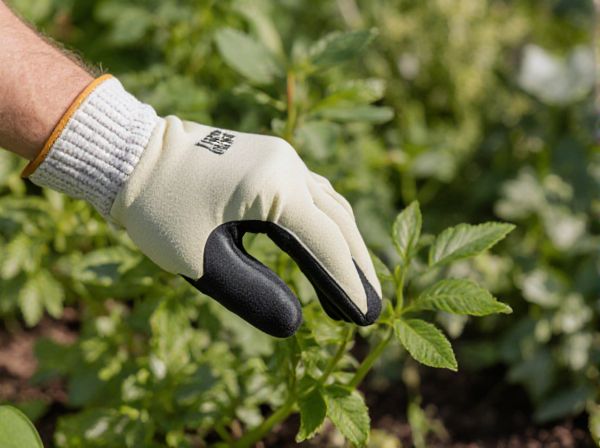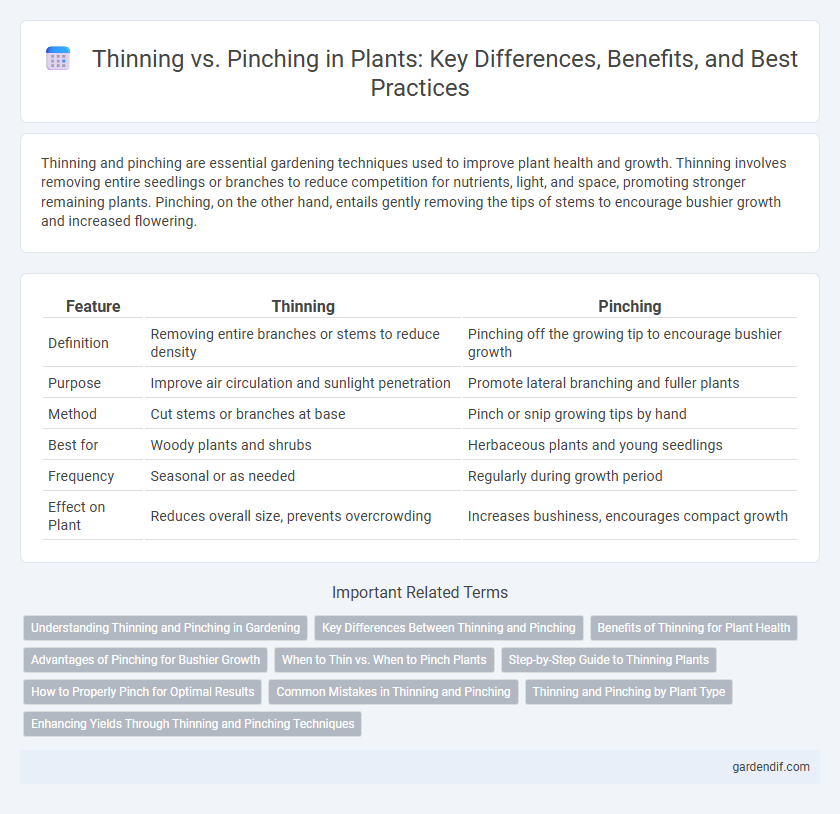
Thinning vs Pinching Illustration
Thinning and pinching are essential gardening techniques used to improve plant health and growth. Thinning involves removing entire seedlings or branches to reduce competition for nutrients, light, and space, promoting stronger remaining plants. Pinching, on the other hand, entails gently removing the tips of stems to encourage bushier growth and increased flowering.
Table of Comparison
| Feature | Thinning | Pinching |
|---|---|---|
| Definition | Removing entire branches or stems to reduce density | Pinching off the growing tip to encourage bushier growth |
| Purpose | Improve air circulation and sunlight penetration | Promote lateral branching and fuller plants |
| Method | Cut stems or branches at base | Pinch or snip growing tips by hand |
| Best for | Woody plants and shrubs | Herbaceous plants and young seedlings |
| Frequency | Seasonal or as needed | Regularly during growth period |
| Effect on Plant | Reduces overall size, prevents overcrowding | Increases bushiness, encourages compact growth |
Understanding Thinning and Pinching in Gardening
Thinning and pinching are essential gardening practices that promote healthy plant growth by managing density and shape. Thinning involves removing entire seedlings or branches to reduce overcrowding and improve air circulation, which helps prevent disease and enhances nutrient availability. Pinching focuses on trimming the tips of young shoots to encourage bushier growth and more abundant flowering, especially in plants like herbs, tomatoes, and flowering annuals.
Key Differences Between Thinning and Pinching
Thinning involves selectively removing entire shoots or stems to improve air circulation and light penetration, which enhances overall plant health and growth. Pinching refers to the removal of the growing tip of a stem to encourage bushier growth and prevent legginess by stimulating lateral bud development. Key differences include thinning targeting whole branches for structural benefits while pinching focuses on terminal growth to modify plant shape and density.
Benefits of Thinning for Plant Health
Thinning improves plant health by reducing overcrowding, which enhances air circulation and decreases the risk of fungal diseases. It allows remaining plants to access more nutrients, water, and sunlight, promoting stronger growth and higher yields. By selectively removing weaker or excess shoots, thinning supports the development of a more vigorous and resilient plant structure.
Advantages of Pinching for Bushier Growth
Pinching promotes bushier growth by encouraging lateral branching and increasing the density of foliage in plants. This technique helps develop a fuller plant structure with more flowers or fruits, improving overall yield and aesthetic appeal. Unlike thinning, pinching maintains plant vigor while shaping growth patterns effectively.
When to Thin vs. When to Pinch Plants
Thin plants during early growth stages to reduce overcrowding and ensure adequate airflow, typically when seedlings develop multiple true leaves. Pinch plants after they reach a certain height or maturity, removing the growing tips to encourage bushier growth and more branching. Choose thinning for spacing and resource allocation, while pinching suits shaping and stimulating denser foliage.
Step-by-Step Guide to Thinning Plants
Thinning plants involves selectively removing weaker seedlings or overcrowded stems to improve air circulation and light penetration, enhancing overall growth. Begin by identifying the healthiest and strongest seedlings, then carefully snip or pull out the weaker ones at soil level to avoid disturbing roots. Maintain regular thinning intervals to prevent overcrowding and promote robust plant development.
How to Properly Pinch for Optimal Results
To properly pinch plants for optimal growth, use your thumb and forefinger to gently remove the soft, new growth at the stem tips, encouraging bushier development and increased branching. Pinching should be performed when the plant reaches about 6 inches tall, targeting the topmost sets of leaves to redirect energy towards lateral shoots. Avoid removing more than one-third of the plant at a time to prevent stress and promote vigorous, healthy growth.
Common Mistakes in Thinning and Pinching
Common mistakes in thinning include removing too many shoots at once, which can stress the plant and reduce overall growth, and thinning at the wrong time, leading to poor air circulation or light penetration. In pinching, errors often involve pinching too late in the growth cycle, causing reduced flowering or fruit development, or pinching too aggressively, which can stunt the plant's progress. Proper timing and moderate removal of growth are crucial to optimize plant health and productivity during thinning and pinching practices.
Thinning and Pinching by Plant Type
Thinning involves selectively removing entire plants or branches to improve air circulation and light penetration, often used for dense crops like tomatoes and peppers to promote healthier growth and higher yields. Pinching refers to the practice of trimming the tips of stems or buds, commonly applied to flowering plants like chrysanthemums and herbs such as basil to encourage bushier growth and more blooms. Different plant types benefit from thinning or pinching based on their growth habits and desired outcomes, with thinning better suited for space management in fruiting vegetables and pinching ideal for shaping ornamental and herbaceous plants.
Enhancing Yields Through Thinning and Pinching Techniques
Thinning and pinching are essential horticultural techniques used to enhance plant yields by promoting healthier growth and maximizing resource allocation. Thinning involves removing excess seedlings or weaker plants to reduce competition, while pinching entails trimming the tips of young shoots to stimulate bushier, more prolific flowering or fruiting. Both methods improve air circulation, light penetration, and nutrient distribution, resulting in higher-quality yields and more robust plant development.
Thinning vs Pinching Infographic

 gardendif.com
gardendif.com